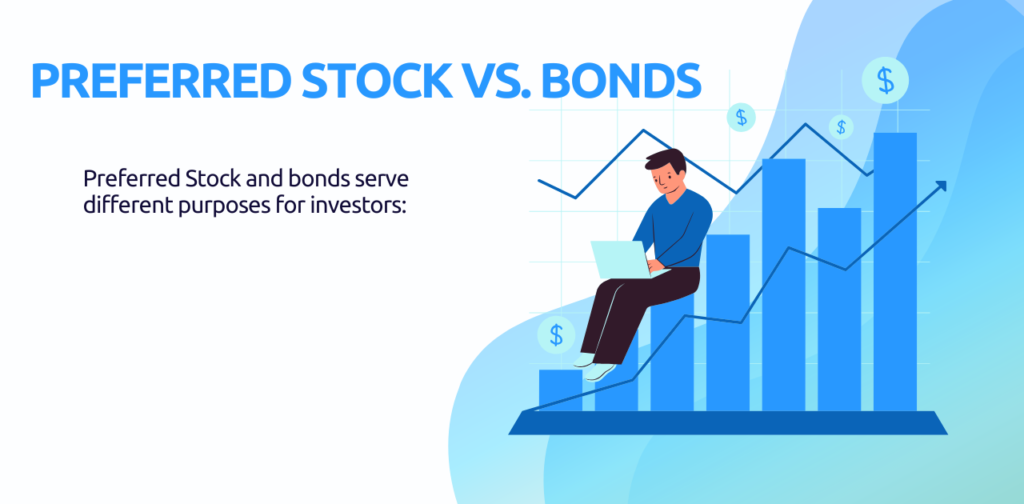Introduction
Preferred stock is a unique type of equity security that blends features of both common stock and bonds. It provides investors with priority dividends and, in some cases, other benefits such as fixed income and convertibility into common shares. While it does not typically offer voting rights, it appeals to investors seeking stable income with lower risk compared to common stock.
This Preferred Stock is commonly issued by financial institutions, real estate investment trusts (REITs), and large corporations that require capital but do not want to dilute common stock ownership. According to a report by S&P Global, financial institutions account for nearly 80% of all such issuances, demonstrating its importance in stabilizing financial markets.
Understanding the Basics
Holders of Preferred Stock have a higher claim on assets and earnings than common shareholders. This means that Preferred Stock in the event of liquidation, they are paid before common shareholders. Additionally, they receive dividends before common stockholders, often at a fixed rate, making them attractive to income-focused investors.
Companies issue these shares as an alternative to debt financing because it allows them to raise capital without increasing debt ratios. This makes it a strategic option for firms looking to strengthen their balance sheets while keeping financial flexibility. For example, many banks issue these shares to comply with capital requirements without affecting their debt-to-equity ratio.
MUST READ: Best Investment Options in India with High Returns In 2025
Preferred Stock vs. Common Stock: Key Differences
- Dividends – These shareholders receive dividends at a fixed rate, whereas common stock dividends can fluctuate based on company performance.
- Voting Rights – Common stockholders typically have voting rights in corporate decisions, while these shareholders usually do not.
- Claim on Assets – This stock has a higher claim on assets and earnings than common shares, especially in liquidation scenarios.
- Risk and Return – Generally less risky than common stock but offers less potential for capital appreciation.
- Market Performance – Common stock prices are driven by market sentiment and company performance, while this stock is more influenced by interest rate changes.
According to financial data, these shares generally yield between 4% and 7%, while common stocks provide variable returns based on market conditions. This makes them an attractive choice for investors seeking reliable income.
For example, if you buy common stock in a tech startup, you could see massive gains if the company succeeds. However, you could also lose your entire investment if the company fails. On the other hand, Preferred Stock in an established company like Coca-Cola would provide steady income with lower risk.
Preferred Stock vs. Bonds: Which Is Better?
Preferred Stock and bonds serve different purposes for investors:

- Fixed Income: Bonds provide guaranteed interest payments, whereas dividends are not always guaranteed.
- Risk Level: Bonds are typically less risky since bondholders have a legal right to interest payments.
- Market Behavior: This Preferred Stock often trades similarly to bonds but carries more risk as it lacks the same legal guarantees for payments.
- Convertibility: Some Preferred Stock can be converted into common shares, offering potential for capital gains.
- Interest Rate Sensitivity: Both are highly sensitive to interest rate movements, affecting their market value.
For instance, if you buy a bond from Apple, you’re essentially lending money to the company. In return, Apple promises to pay you interest and return your principal at maturity. With Preferred Stock, you’re buying a share of the company and receiving dividends, but you’re not guaranteed to get your principal back.
Types Preferred Stock
These shares come in various forms, each offering unique benefits:
Prior Preferred Stock
This is the highest-ranking type, ensuring dividends are paid first before other categories. It is ideal for investors seeking security and stability. Large banks and insurance companies often issue these to attract conservative investors.
Preference Preferred Stock
Preferred Stock rank just below prior preferred but still have a higher claim on dividends than common stockholders. Investors benefit from more predictable income streams.
Perpetual Preferred Stock
Preferred Stock shares have no maturity date, meaning investors can hold them indefinitely while receiving dividends. Many REITs and large utility companies issue these to secure long-term investment.
Convertible Preferred Stock
This Preferred Stock allows shareholders to convert their shares into common stock under predefined conditions. It offers potential capital gains alongside dividend income. Investors may choose conversion when common stock prices appreciate significantly, maximizing returns.
Cumulative Preferred Stock
If a company skips a dividend payment, these shareholders have the right to receive those missed payments before common shareholders receive any dividends. This feature provides greater security for investors. Companies with fluctuating cash flows often issue cumulative shares to maintain investor confidence.
Noncumulative Preferred Stock
Unlike cumulative shares, these do not guarantee the payment of missed dividends. This type is riskier for investors but may be more beneficial for companies, as it provides greater financial flexibility.
Participating Preferred Stock
Preferred Stock allows shareholders to receive additional dividends based on company profits, in addition to their fixed dividend rate. If a company performs exceptionally well, these shareholders can earn higher returns.
How It Works
These shares function differently based on their structure and features. Investors should understand key elements such as:
Voting Rights, Calling, and Convertibility
Voting Rights
Most of Preferred Stock shares do not grant voting rights to shareholders, which means investors have limited influence over corporate decisions. Unlike common stockholders, who can vote on board members and corporate policies, these shareholders typically focus on stable income rather than governance involvement. However, in some cases, if a company fails to pay dividends for a specified period, shareholders may temporarily gain voting rights to protect their interests.
Callability
Many of Preferred Stock are callable, meaning the issuing company has the right to repurchase them at a predetermined price after a certain period. This feature allows companies to reduce dividend obligations if market interest rates decline or if they want to restructure their capital. While callability benefits companies by providing financial flexibility, it can pose a risk for investors if the stock is called away at a lower price than its market value, leading to potential losses.
Convertibility
Some Preferred Stock have a convertibility feature, allowing investors to exchange their shares for a predetermined number of common shares. This option provides growth potential, especially if the company’s common stock experiences significant appreciation. Convertible shares appeal to investors looking for a combination of steady dividends and the opportunity for capital gains. However, convertibility terms vary, and investors should assess the conditions before investing.
Companies in Distress: How It Fits In
Preferred Stock can be an attractive financing option for struggling companies. It provides them with capital without increasing debt, while still offering investors potential dividend payments and a claim on assets. During economic downturns, companies like General Motors and major banks have issued these stocks to secure funding without increasing their liabilities.
Typical Buyers: Who Invests?
These shares attract a variety of investors, including:
- Income-seeking investors who prioritize stable dividends.
- Institutional investors such as banks and insurance companies that benefit from steady returns.
- Risk-averse investors looking for an alternative to common stock with lower volatility.
- Hedge funds that use these stocks for arbitrage opportunities, taking advantage of price differences between preferred and common shares.
Advantages and Disadvantages
Advantages:
- Priority dividend payments over common stock
- More predictable returns compared to common shares
- Higher claim on company assets during liquidation
- Convertible options provide growth potential
- Perpetual nature allows long-term income generation
Disadvantages:
- Limited or no voting rights
- Callability risk if the company repurchases shares
- Lower capital appreciation potential than common stock
- Dividend payments can be suspended
- Sensitive to interest rate fluctuations
Conclusion
Preferred Stock offers a balanced investment option between bonds and common stock. It provides stable income, lower risk, and priority over common shareholders in dividend payments and liquidation. However, it comes with limitations such as lack of voting rights and potential callability. Investors should carefully assess their financial goals before choosing this stock as part of their investment portfolio.
Frequently Asked Questions (FAQs)
- What is the difference between Preferred Stock and Common Stock?
- Preferred shareholders receive fixed dividends and have priority in bankruptcy, while common shareholders have voting rights and higher growth potential.
- Can you lose money on Preferred Stock?
- Yes, if the company faces financial trouble or interest rates rise.
- Is Preferred Stock safer than Common Stock?
- Generally, yes, but it’s not risk-free.
Riyo is a Digital Marketing expert with specialization in SEO and Market Analysis. He has hands-on experience in keyword research, on-page & off-page SEO, and data-driven marketing strategies. Riyo helps businesses boost their online visibility and grow through smart digital tactics.


